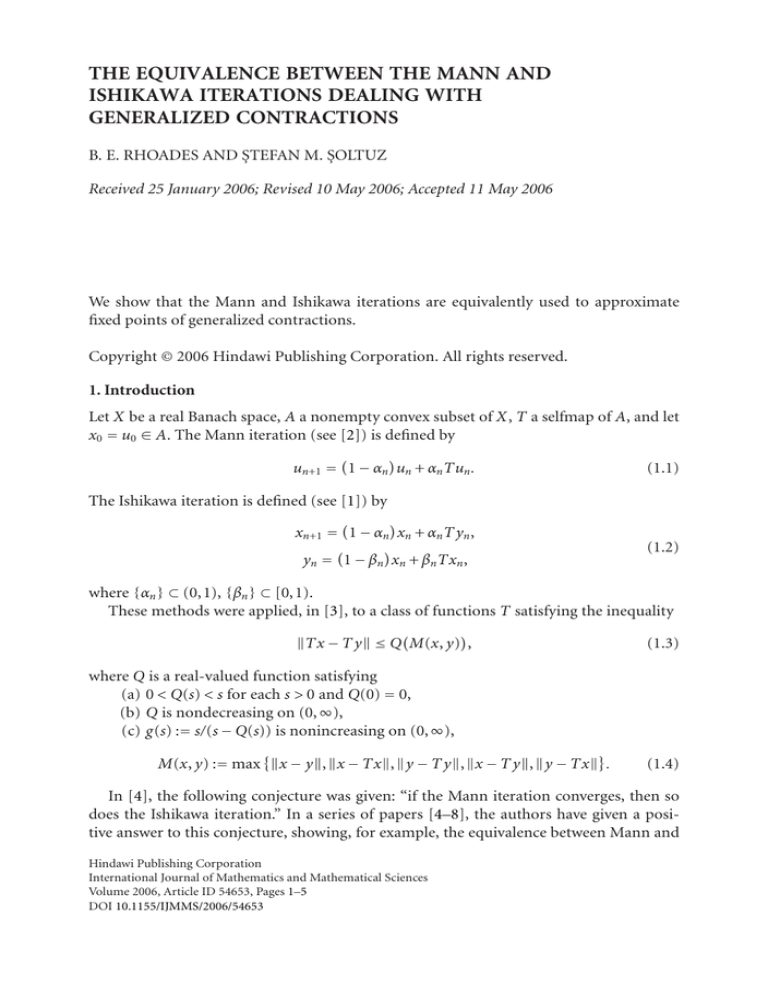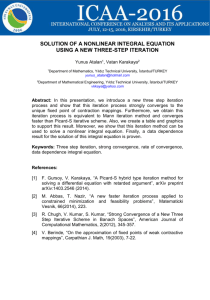
THE EQUIVALENCE BETWEEN THE MANN AND
ISHIKAWA ITERATIONS DEALING WITH
GENERALIZED CONTRACTIONS
B. E. RHOADES AND ŞTEFAN M. ŞOLTUZ
Received 25 January 2006; Revised 10 May 2006; Accepted 11 May 2006
We show that the Mann and Ishikawa iterations are equivalently used to approximate
fixed points of generalized contractions.
Copyright © 2006 Hindawi Publishing Corporation. All rights reserved.
1. Introduction
Let X be a real Banach space, A a nonempty convex subset of X, T a selfmap of A, and let
x0 = u0 ∈ A. The Mann iteration (see [2]) is defined by
un+1 = 1 − αn un + αn Tun .
(1.1)
The Ishikawa iteration is defined (see [1]) by
xn+1 = 1 − αn xn + αn T yn ,
(1.2)
yn = 1 − βn xn + βn Txn ,
where {αn } ⊂ (0,1), {βn } ⊂ [0,1).
These methods were applied, in [3], to a class of functions T satisfying the inequality
Tx − T y ≤ Q M(x, y) ,
(1.3)
where Q is a real-valued function satisfying
(a) 0 < Q(s) < s for each s > 0 and Q(0) = 0,
(b) Q is nondecreasing on (0, ∞),
(c) g(s) := s/(s − Q(s)) is nonincreasing on (0, ∞),
M(x, y) := max x − y , x − Tx, y − T y , x − T y , y − Tx .
(1.4)
In [4], the following conjecture was given: “if the Mann iteration converges, then so
does the Ishikawa iteration.” In a series of papers [4–8], the authors have given a positive answer to this conjecture, showing, for example, the equivalence between Mann and
Hindawi Publishing Corporation
International Journal of Mathematics and Mathematical Sciences
Volume 2006, Article ID 54653, Pages 1–5
DOI 10.1155/IJMMS/2006/54653
2
Equivalent iterations for generalized contractions
Ishikawa iterations for strongly and uniformly pseudocontractive maps. In this note, we
show that the convergence of Mann iteration is equivalent to the convergence of Ishikawa
iteration, used to approximate fixed points of a map which satisfies condition (1.3). Such
a map is independent of the class of strongly pseudocontractive maps. The class of generalized contractions satisfying (1.3) generalizes the class of quasi-contractions, see, for example, [9]. Thus, our result generalizes the main [9, Theorem 1], which states the equivalence between Mann and Ishikawa iterations when applied to quasi-contractions.
Lemma 1.1 [10]. Let {an } be a nonnegative sequence which satisfies the following inequality:
an+1 ≤ 1 − λn an + σn ,
where λn ∈ (0,1) for all n ≥ n0 ,
∞
n =1 λ n
(1.5)
= ∞, and σn = o(λn ). Then limn→∞ an = 0.
The following result is a lemma from [3, page 351].
Lemma 1.2 [3]. Let A be a nonempty closed convex subset of a Banach space X, and T
aself-map of A satisfying (1.3). Let {αn } satisfy the conditions αn > 0 for all n ≥ 0 and
∞
n=0 αn = ∞. Then the sequences {xn }, { yn }, {un }, {Txn }, {T yn }, and {Tun } are bounded.
2. Main result
Theorem 2.1. Let A be a nonempty closed convex subset of a Banach space X, and T
aself-map of A satisfying (1.3). Let {αn } satisfy the conditions αn > 0 for all n ≥ 0 and
∞
∗
n=0 αn = ∞. Denote by x the unique fixed point of T. Then for u0 = x0 ∈ A, the following
are equivalent:
(i) the Mann iteration (1.1) converges to x∗ ;
(ii) the Ishikawa iteration (1.2) converges to x∗ .
Proof. Lemma 1.2 assures that both Mann and Ishikawa iterations are bounded and
hence, in order to prove the equivalence between (1.1) and (1.2), we need to prove that
lim xn − un = 0.
n→∞
Set
rn = max sup xn − T y j : j ≥ n ∪ sup un − Tu j : j ≥ n
∪ sup xn − Tu j : j ≥ n ∪ sup un − T y j : j ≥ n .
(2.1)
(2.2)
Then the following are true:
xn − T y j ≤ 1 − αn−1 xn−1 − T y j + αn−1 T yn−1 − T y j ≤ 1 − αn−1 rn−1 + αn−1 Q M yn−1 , y j
≤ 1 − αn−1 rn−1 + αn−1 Q rn−1 ,
un − Tu j ≤ 1 − αn−1 un−1 − Tu j + αn−1 Tun−1 − Tu j ≤ 1 − αn−1 rn−1 + αn−1 Q M un−1 ,u j
≤ 1 − αn−1 rn−1 + αn−1 Q rn−1 ,
(2.3)
B. E. Rhoades and Ş. M. Şoltuz 3
moreover,
xn − Tu j ≤ 1 − αn−1 xn−1 − Tu j + αn−1 T yn−1 − Tu j ≤ 1 − αn−1 rn−1 + αn−1 Q M yn−1 ,u j
≤ 1 − αn−1 rn−1 + αn−1 Q rn−1 ,
(2.4)
also,
un − T y j ≤ 1 − αn−1 un−1 − T y j + αn−1 Tun−1 − T y j ≤ 1 − αn−1 rn−1 + αn−1 Q M un−1 , y j
≤ 1 − αn−1 rn−1 + αn−1 Q rn−1 .
(2.5)
Eventually, one gets the following evaluation:
rn ≤ 1 − αn−1 rn−1 + αn−1 Q rn−1 ⇐⇒ αn−1 g rn−1 ≤ rn−1 − rn ,
(2.6)
which implies that {rn } is nonincreasing in n and positive. Hence, there exists limn→∞ rn ,
denoted by r ≥ 0. Suppose r > 0. From (2.6), we obtain
αn−1 g(r) ≤ αn−1 g rn−1 ≤ rn−1 − rn ⇐⇒ g(r)
n
αk ≤
k =0
n
rk − rk−1 = r0 − rn+1 .
(2.7)
k =0
The right-hand side is bounded and the left-hand side is unbounded. Thus, r = 0. Hence,
lim xn − Tun = 0,
lim un − T yn = 0,
n→∞
n→∞
n→∞
n→∞
lim xn − T yn = 0,
lim un − Tun = 0.
(2.8)
Suppose now that the Mann iteration converges, then one has
xn+1 − un+1 ≤ 1 − αn xn − un + αn T yn − Tun ≤ 1 − αn xn − un + αn T yn − xn + xn − Tun .
(2.9)
Using (2.8) and (2.9) and Lemma 1.1, with
λn := xn − un ,
σn := αn T yn − xn + xn − Tun ,
σn = o αn ,
(2.10)
4
Equivalent iterations for generalized contractions
we have limn→∞ λn = 0, that is, (2.1) holds. The relation
xn − x∗ ≤ xn − un + x∗ − un −→ 0
(2.11)
leads to the conclusion that Ishikawa iteration converges too. Suppose now that the Ishikawa iteration converges, then one has
xn+1 − un+1 ≤ 1 − αn xn − un + αn T yn − Tun ≤ 1 − αn xn − un + αn T yn − un + un − Tun .
(2.12)
Using (2.8) and (2.12) and Lemma 1.1, with
λn := xn − un ,
σn := αn T yn − un + un − Tun ,
(2.13)
σn = o αn ,
we have limn→∞ λn = 0, that is, (2.1) holds. The relation
un − x∗ ≤ xn − un + xn − x∗ −→ 0
leads to the conclusion that Mann iteration converges too.
(2.14)
Acknowledgment
The authors are indebted to the referees for carefully reading this note and for making
useful suggestions.
References
[1] S. Ishikawa, Fixed points by a new iteration method, Proceedings of the American Mathematical
Society 44 (1974), no. 1, 147–150.
[2] W. R. Mann, Mean value methods in iteration, Proceedings of the American Mathematical Society 4 (1953), no. 3, 506–510.
[3] B. E. Rhoades, Convergence of an Ishikawa-type iteration scheme for a generalized contraction,
Journal of Mathematical Analysis and Applications 185 (1994), no. 2, 350–355.
[4] B. E. Rhoades and Ş. M. Şoltuz, On the equivalence of Mann and Ishikawa iteration methods,
International Journal of Mathematics and Mathematical Sciences 2003 (2003), no. 7, 451–459.
, The equivalence between the convergences of Ishikawa and Mann iterations for an asymp[5]
totically pseudocontractive map, Journal of Mathematical Analysis and Applications 283 (2003),
no. 2, 681–688.
, The equivalence of Mann iteration and Ishikawa iteration for non-Lipschitzian operators,
[6]
International Journal of Mathematics and Mathematical Sciences 2003 (2003), no. 42, 2645–
2651.
, The equivalence between the convergences of Ishikawa and Mann iterations for an asymp[7]
totically nonexpansive in the intermediate sense and strongly successively pseudocontractive maps,
Journal of Mathematical Analysis and Applications 289 (2004), no. 1, 266–278.
, The equivalence of Mann iteration and Ishikawa iteration for a Lipschitzian ψ-uniformly
[8]
pseudocontractive and ψ-uniformly accretive maps, Tamkang Journal of Mathematics 35 (2004),
no. 3, 235–245.
B. E. Rhoades and Ş. M. Şoltuz 5
[9] Ş. M. Şoltuz, The equivalence of Picard, Mann and Ishikawa iterations dealing with quasi-contractive operators, Mathematical Communications 10 (2005), no. 1, 81–88.
[10] X. Weng, Fixed point iteration for local strictly pseudo-contractive mapping, Proceedings of the
American Mathematical Society 113 (1991), no. 3, 727–731.
B. E. Rhoades: Department of Mathematics, Indiana University, Bloomington, IN 47405-7106, USA
E-mail address: rhoades@indiana.edu
Ştefan M. Şoltuz: “Tiberiu Popoviciu” Institute of Numerical Analysis, Romanian Academy,
Tiberiu Popoviciu, P.O. Box 68-1, 400110 Cluj-Napoca, Romania
E-mail addresses: smsoltuz@gmail.com; soltuzul@yahoo.com







